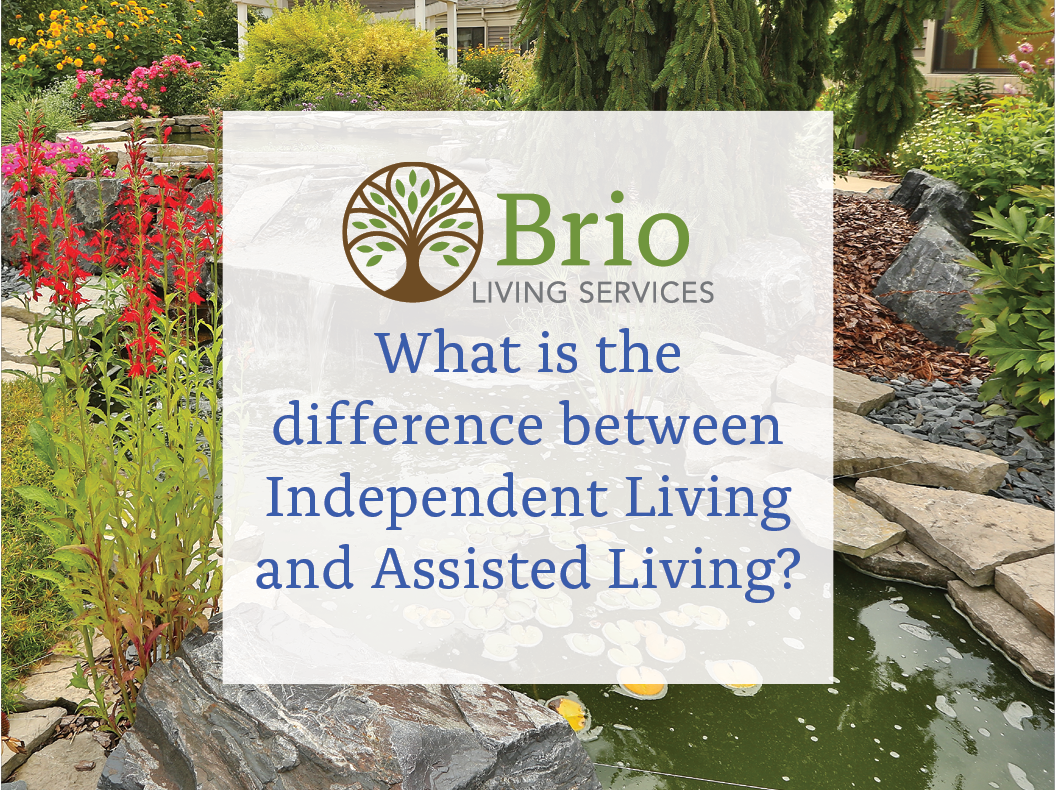
Researching retirement communities can be daunting, and you may realize there is much more to it than you thought. Between price structures, locations, and levels of living, it can feel like a whole new language to learn! At Brio Living Services, our Sales Advisors are here to help! We aim to provide unbiased information, about not only the living options we offer at Brio Living Services, but about options available throughout the state as well. We always encourage our future residents to do their research and find what truly works for them.
Upon starting your search, a common question is, “what is the difference between independent living and assisted living?” Both independent living and assisted living have their own benefits, and throughout our blog we will decipher the differences between the two and provide some helpful tools for your search.
Living Accommodations
Living spaces can differ for very particular reasons in independent living and assisted living. Typically, an independent living accommodation is larger than assisted living in square footage, and often may have more than one bedroom. It may vary from an apartment style, all the way to a ground level, stand-alone home. Typically, an independent living residence will have a full kitchen with appliances, washer and dryer, and sometimes even a garage. An assisted living accommodation will most likely be an apartment style home, with an open layout, to navigate safely and easily throughout. Appliances are not necessary or included, as assisted living residents receive more services and amenities than independent living residents.
Services Provided
This is where future residents will likely find the most significant differences between independent and assisted living environments. In independent living communities, services received are based on ensuring a convenient lifestyle for residents. These types of services include, but are not limited to, housekeeping, interior and exterior maintenance, and dining options. The hope is that independent living residents spend less time on “chores,” and more time enjoying the lifestyle at the community. Assisted living services differ greatly because of the care provided for each resident. 24/7 staffing is a key part of assisted living for residents who require more care. Highly trained team members such as social workers, memory care specialists, and registered nurses work together to provide individualized care plans for residents within an assisted living community. Team members are available at the push of a button to ease the minds of residents and loved ones, providing assistance with activities of daily living (or ADLs) like hygiene assistance, bathing and dressing, and medication management. At Brio Living Services, we know it can be difficult to know if you or a loved one are ready for assisted living. Learn more about signs to look for that you or a loved one might be ready for a move to assisted living.
Amenities Included
Amenities offered in independent and assisted living settings are often similar. Both settings will offer robust monthly activity and event calendars, though the types of events may vary between the two groups. Events like happy hours, trips to museums, book clubs, discussion groups, and art exhibits, are all common social and cultural recreation opportunities that ideal communities will offer. Often, both settings will also provide on-site fitness centers with instructors and classes, transportation options, and engaging common spaces such as libraries, theaters, and chapels. Many communities also provide common outdoor spaces, featuring walking paths, cutting or community gardens, and putt-putt courses!
Cost Structures
Cost structures between the independent living and assisted living environments will differ greatly. Independent living options may offer both a rental option and an entrance fee option. An entrance fee model, in short, is a percentage refundable (upon move out) amount that is paid prior to a move in, with an additional monthly fee to cover the services mentioned above. The cost structure for assisted living is typically a rental model, with those monthly rates being higher than an independent living model rental, due to the care and scope of additional services being provided to the individual. Assisted living cost structures may vary from community to community between tiered-level pricing based on needs, and all-inclusive rates. Both independent and assisted living costs are typically paid out of pocket, although some Long-Term Care insurance policies may cover portions of assisted living costs. Utilities, telephone, internet, and cable services may or may not be provided in both cost structures; this is a good question to ask while researching options. We encourage customers to utilize our helpful checklists to help aid in your retirement community search.
We often find that many new customers starting their research associate retirement communities with a highly medical, hospital-type atmosphere, when in most cases, that could not be further from the truth. Both environments aim to add peace of mind and convenient, fulfilling lifestyles for residents. Many residents tell us that they wish they would have made the move sooner! Brio Living Services strives to provide environments where residents don’t just survive, but thrive within the community. We look forward to helping you learn more about independent and assisted living options at Brio Living Services at www.MyBrio.org.
